Testimonies
Here is a selection of testimonies submitted to us via e-mail or Facebook, and originally published on our Hungarian-language website. These testimonies were selected and, unless stated otherwise, translated into English by Gwen Jones. To submit a story, please write to bertalan@ceu.edu.
2014. May 19., Monday

Before the compulsory relocation [into yellow-star houses] I lived with my parents at Visegrádi Street 5/b, in a small ground-floor apartment, while my paternal grandparents lived opposite us at Visegrádi Street 6, in a second-floor, two-room apartment that could be described as middle-class. From here, we ended up together with my mother and grandparents in the designated yellow-star house at Visegrádi Street 3. I suspect that my grandfather and the earlier tenants may have agreed an exchange, which is how we came to live in a relatively large fourth-floor apartment, and thus were not a burden to anyone. During the move, none of us took any furniture with us, neither us or my grandparents, and perhaps taking furniture was even not allowed. Before the move, my grandfather had had to hand in his all-waveband radio.
My parents knew some people in the new house. On the third floor lived a lawyer named Szőnyi who was active in politics, with his wife who was a doctor. On the fourth floor was another left-wing lawyer, Ervin Neufeld, with his lovely wife Mufi, a eurythmic artist. Both men were soon called up for forced labor service, and neither of them returned.
There were countless children living in the house, and who soon formed a little gang, led by two older adolescents. One of them, blond Pista, was the youngest son of Schleiffer, the lawyer who lived on the second floor; Pista would grow up to be the writer István Eörsi. The other leader of the gang was a devilish-looking, black-haired lad, Péter Vajda, who’s still alive today and well known as a journalist. We were in permanent conflict with the couple who owned the house. The husband, Mr. Kertész, had earlier been a famous footballer and his wife was the one who brought the property into the marriage, which she looked after even in these exceptional circumstances. She would often scream at us not to make a racket in the courtyard, not to climb on the carpet-beater frame. We took no notice of the restrictions and rushed around the walkways and the attic, and when it wasn’t forbidden to leave the house, we played tennis matches with our feet on the neighboring Borbély Street, with other children from the area. For me, the main consequence of being in a gang was that my vocabulary grew in a particular way, which my mother noted with great patience.
The adults’ lives were, of course, much more troubled. During the brief hours we were allowed to go outside, it was difficult to acquire food. This was my mother’s task, which she duly completed. Ever since spring, Allied bombings in our area had become a regular occurrence, close to Nyugati railway station. After the bombings, younger able-bodied adults were made to clear the rubble. My mother also took part in this work. One she worked on the ruins of a house where the bomb had blown up the sewage pipe. Having seen that, she never went down to the basement and didn’t let me go down their either.
All of us were distressed that we knew almost nothing about close family members. My aunt was pregnant and living in her husband’s village when the Germans occupied Hungary, and so she was deported together with her family to Auschwitz which, of course, we didn’t know. Although we had received a mysterious postcard from a place called Waldsee with pre-printed text and her husband’s signature, which both reassured and worried us. We learned later that the couple had survived the selection and been made to work, they both survived and returned home after liberation. We had no news of my father and the only thing we knew about my uncle was that he had disappeared on the Eastern Front in the winter of 1942. We only learned after 1945 that “luckily,” he had only been taken into captivity, from where he returned home in 1949. My father’s younger brother was involved in some illegal Jewish organization and was living with false papers somewhere; he would pop up most unexpectedly. My mother was convinced that my father was live, that he would return home, and she tried to reassure the grandparents. She couldn’t imagine how risky the journey would be from the Bor forced labor camp in Serbia—which we hadn’t even heard of—back to Hungary. In any case, constant reassurance was necessary, since news was spreading through the city of new hardships for the Jews, the reasons behind which are now well known today, but at the time, the community under threat had no idea of what was happening. The atmosphere of panic was illustrated by the fact that at the Greek Catholic priests’ office operating in the house, people queued in lines for days. Perhaps it was this sight that spurred my grandfather to take me to the basement of a restaurant on the corner of Szent István Boulevard and Honvéd Street, where community sisters held lecturers for those intending to convert. The basement I still remember, but not what the nice sister had to say. One of my experiences is related to this visit. Not much later, I heard one morning that my grandfather was reading some text and trying to learn it by heart. I went over to him and saw that he was memorizing the catechism. I asked him what he was doing this for. “For you and the others, my little boy,” was his reply. I thought this situation was humiliating, because in my eyes he was a World War I hero, and I was ashamed that now he was cramming from an elementary school textbook, for some sort of uncertain justification. I asked him not to do it, and told him I’d never go to the nuns’ talks again.
From the end of July, the earlier tense atmosphere gradually improved. Even without a radio, we could tell from the adults’ conversations that maybe the hardships would be coming to an end. Insinuations and rumors were circulating that the sort of change might happen here as had happened in Italy in 1943. Horthy had dismissed Döme Sztójay, the occupiers’ confidential man, and appointed General Géza Lakatos as head of the government, and many people hoped that we would also go the way of the Italians. When we went to see my aunt’s newborn son Péter on October 10, 1944, I saw some graffiti on the neighbors’ wall: long live Marshal Badoglio. From the conversations at home, I understood what the author of this message wanted to communicate to passers-by, and I wasn’t surprised when my grandfather had discussed with some of his friends who’d been in the army to organize protection for the house. On Horthy’s proclamation of October 15 [that Hungary was leaving the war], the house guard occupied its place at the front gate. In the early afternoon, my grandfather saw their former neighbor, a coal trader, in Arrow Cross uniform. He interpreted seeing the uniformed Arrow Cross man as a sign that opposition was forming against Horthy, which he could not tolerate. He stepped out of the house, seized the wretch and beat him with a broom handle. It turned out a couple of hours later that this was of no help to Horthy, since the Arrow Cross had seized power with German help, and of course he also had to fear reprisal. This is why my grandparents went into hiding, and to this day I don’t know where. These two older citizens couldn’t live illegally. They were caught and taken to the Arrow Cross house at Szent István Boulevard 2.
They were lucky in that summary executions had not yet come into fashion. My grandfather was badly beaten many times, and his death in April 1945 was a result of these assaults. But they left my grandmother alone, and after a week in captivity, they were released. They then spent the siege of Budapest in a protected house on Tátra Street. From October 15, we stayed with my mother in the yellow-star house. We lived through frequent Arrow Cross raids, we were together at the KISOK sports fields in Zugló, where the metro station is today. We had to go there in the mornings. There were thousands of us there, and Arrow Cross groups organized people into groups and led them off somewhere. My mother always led me in the direction of crowds not yet sorted into groups, and that’s how we got out of being marshaled until the afternoon. Then a Hungarian military officer arrived and intervened so that the rest of the people still there were chased home. We were still living at Visegrádi Street 3 when Margit Bridge was blown up. I remember well the detonation and the yellowish light of the explosion. Not much later an Arrow Cross commando arrived in the house and gathered up the women judged fit to work. This included my mother and her friend Mufi. When I saw that they would be taken away, I started kicking up a fuss and cursing, since apart from my mother, I had nobody. The fuss surprised the leader of the detachment, he praised my bravery, and then still took my mother away to the Óbuda brick factory, as I later learned. They used the same avoidance tactics here as they had at the KISOK fields.
However, they noticed that a Swiss diplomat had appeared to rescue the people with protection documents from captivity, my mother and her friend joined his group and thus got out of the Brick Factory. I have no idea how they got hold of a Swiss protection letter, but we soon moved into the Swiss protected house at Pozsonyi Road 49. My “protection” lasted for two months, until January 15, 1945.
János Kende, historian.

Here is a description of Perczel Mór Street 4, where I live. The original owner, Mrs. Vilmos Grauer, lived in our apartment and next door’s too. Her husband was a vinegar producer, and her father, Mr. Herzmann, built the whole house. During the war, there were apparently five Jewish families living in our apartment.
The earlier owner told me the following, and I’ve just asked him for the details. He sent me the following documents:
Perczel Mór Street 4.
… Mrs. József Varga moved into the house as concierge from April 1, 1944. About the history of the house, she said:
The building was built by Bertalan Herzmann for Mrs. Vilmos Grauer. The widow Grauer lived on the third floor, and they had a vinegar factory at Rákóczi Road 49.
On the first floor lived General Géza Lakatos, the Prime Minister, with his wife, sister and Elemér Ragályi, his brother-in-law. The Arrow Cross placed the yellow star on the house while the Lakatos family still lived there.
The second floor was inhabited by Mrs. Zsigmond Erdély with her son Aurél and his family. They were the owners of the “Agrár Industria” Company. The Company’s office was also in their apartment. The Soldiers’ Resistance Movement had one of their meeting places in the Erdély family’s apartment. Vilmos Tartsay and János Kiss were seen there many times.
The widow Mrs. Vilmos Grauer received a protection document from the Arrow Cross [Hungarian State Security Surveillance chief] Péter Hain, and the house became a yellow-star house. Mrs. Grauer looked after abandoned and orphaned Jewish children in her apartment. She used typhus infection certificates from the local district medical officer, Dr. Dobi, to stop the Arrow Cross from harassing her so much. The Swedish embassy secretary Raoul Wallenberg brought food for the children in the house.
On Christmas night 1944, the Arrow Cross wanted to drive the children out, but Mrs. Varga begged her way out of the house, and ran to the German command on Október 6 Street. From there she begged an SS major called Kurt to go back with her to the house, and he chased the Arrow Cross out of the building. This is how the children could escape.
Many bombs fell on the house, but none exploded, so there was no significant damage.
I learned from the story that although the widow Mrs. Grauer and her son had a protection letter, the Arrow Cross still executed them.
On January 18, 1945, the Russians occupied the house and for the residents, this meant the storm of war had passed.
The owners of the property:
1900: Hungarian Royal Treasury
1912: Bertalan Herzmann and his wife
1928: Dr. Vilmos Grauer
1937: Mrs. Vilmos Grauer
Tibor Végh
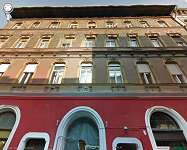
My father Imre Nádor (Neuman) lived in the house at Dob Street 52. It's from here that he was taken away for so long. On September 1, 1940, he was taken on forced labor service from here via Vác to Transylvania, from where he was demobilized on March 31, 1941. Freedom didn't last long: on May 1, 1942, he was taken again via Vác to Ukraine, and from there on March 27, 1944, via Hungary to Mauthausen, where he was liberated on May 5, 1945. He arrived in Budapest on August 31, 1945. As one can see, this took four and a half years from his life. I knew this until now, but as I write it down, I shudder.
2014. May 15., Thursday
Gömb Street 36 – Szegedi Road 9 – Üteg Street 18.
This large, U-shaped house in Angyalföld had entrances on three streets, and was designated as a “yellow-star house.” It was in fact a mixed house, lots of the old residents stayed on living there. There were no problems between them, as children we played together. Its advantages was that it had many front gates, and so it was often possible to trick the Arrow Cross, who would have gathered us all up. I’d be glad if anyone else who was there got in touch.
2014. May 13., Tuesday
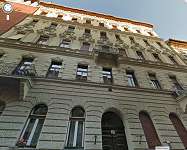
I and my mother stayed at VI. Eötvös Street 27, sharing a one-roomed apartment with an aunt and great-aunt. I remember rather painfully that my father came to visit us from his forced labour unit for a couple of days (a great privilege, gained with heavy bribes), but the concierge got very worried about his unregistered presence in the house, and reported him to the Arrow Cross. He was dragged away and we never saw him again. My mother then found out that in a few days the occupants of the building were going to be transferred to the ghetto, and she managed to get us out into a 'protected house' of the Swedish Embassy - but that's another story.
2014. May 12., Monday
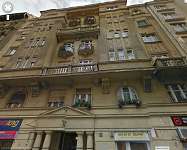
We were liberated in Katona József Street 10/a. This was a Swedish protected house, and all three of us--my father, mother and me--owned Swedish protection passports. I was a child at the time, but I remember that we were afraid of the concierge. My father left the house without his yellow star on, to find bread. Before the Russians arrived, a horse died in front of the gate. I remember that there were soldiers on the fourth floor looking in the direction of the Víg Theater to see what had happened. I know that everyone was taken from the house on the corner of Csáky Street and the other side of Katona József Street, and shot into the Danube, because the concierge had denounced the house at the nearby Arrow Cross house on Szent István Boulevard 6. I think that was a Swedish protected house too. The concierge was later captured, but that didn't help the people who had been killed.
Before my father acquired the Swedish protection passport, we were living in the Jewish house with my mother, just the two of us, because my father had been taken away (that's a long story). One day, some gendarmes and Arrow Cross men came into the house and everyone had to assemble in the courtyard. They ordered us outside to be taken to dig ramparts. All the apartments were mostly full of women and children, all sharing an apartment. They took us out to the Horseracing Track, where we spent the whole day waiting. Women with Christian husbands were standing in a separate line, and they had telegrams to prove that their husbands had died a hero's death. I only wanted to stay with my mother's friend who was standing in this line. We snuck over and the women hid us somehow. Every group left for somewhere, and only that group was allowed to return home late at night. We didn't have any sort of papers on us, but a guard at the gate must have felt sorry for us and let both of us out. It was only after the war that we learned that everyone else had been taken to Auschwitz or other camps, and only one person returned from there. The children I had played with on the corridor of the house never came back.
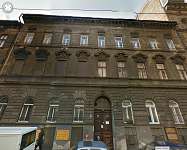
One episode from the many hardships endured during early fall 1944, in the yellow-star house at Izabella Street 52, sixth district:
I moved into this residential house in 1938, at the age of 11, with my parents and older sister. The house had an internal walkway and no elevator, and the people who lived there were generally lower middle-class or poor. Given my age at the time, I only partly perceived the approaching danger and tragedies. By the time March 19, 1944 came around, I had grown up, although I wouldn’t say this period was a carefree teenage era, but rather a youth that was stolen, made impossible, and which preceded and followed those days. For this reason, I still feel that loss to this day.
Since we lived at Izabella Street 52, close to Andrássy Avenue, on that day [March 19], with lumps in our throats and full of fear, we saw with our own eyes the German tanks and military vehicles proceeding up towards Heroes’ Square. Accompanied by German marching tunes, legions of soldiers marched in disciplined columns, their boots clacking. It was hair-raising. I was at home; there was no school.
The situation grew worse from day to day. If I remember well, they ordered the establishment of yellow-star houses in April [NB: it was June]. This meant that the yellow star appeared on 10-20 houses, and whoever didn’t live in one of these houses had to leave their home within 2-3 days, and somehow find a place in a designated yellow-star house. Of course, the Christians living in yellow-star houses had to leave their apartments in a hurry so that they could choose from among the far better Jewish apartments, and they could take all their things with them.
If we can call it luck, Izabella Street 52 became a yellow-star house. We had to take in three more families into our apartment, plus an 80-year-old grandmother, who arrived with her belongings. One can imagine how we had to live, with so many people sharing a small bathroom and one kitchen. We hardly had anything to eat, and because of the curfew, we could only go out for a few hours a day, when people descended on the almost empty shops.
At that point, the concierge system was still functioning. From the service apartment, they oversaw order in the house, cleaned, and so on. Well, we landed an absolutely malicious, cruel concierge couple, who were more antisemitic than the average. They were the only Aryan family in the house, and they made it their duty to oversee strict compliance with the sanctions against Jews, and they ordered us to inform on one another. Out of fear, they went over and above what was necessary. Since the concierge was also the house supervisor, if something had to be conveyed to the house, they sounded the “bell” using a pestle and mortar, at which everyone rushed out of their apartments. One late October or early November noon, we heard this signal again. When we went out to listen, we saw that a squad of Arrow Cross commandos had invaded the courtyard, who ordered everyone to immediately come down into the courtyard in their coats, and without any luggage. Like sheep, we took with us the 6-7-week-old baby and one-year-old child downstairs with us, obeying the order without opposition, just like the rest of the residents. Once the people of the house were gathered together, the Arrow Cross informed us that they were taking us away. They didn’t say where to, but the front gate was locked so that nobody could escape. As we stood waiting to depart, having left our apartment front doors open, that’s when we heard the famous statement: “CAN I LET ‘EM OUT?” from the concierge who, gloating, then opened the front gate and led the residents out onto the street. There must have been 150-200 of us. We briefly saw other similar groups, with whom we were joined up to make a long marching column. Armed Arrow Cross striplings escorted us on both sides, holding us in their rifle sights, and issued the word of command: Long live Szálasi! This is how we were force-marched for a long time, hands in the air, until we learned that our destination was the Tattersaal (later Ügetőpálya) racing track, behind Keleti Station in Pest. We reached there at dusk. It was a huge, empty space, capable of holding thousands of people, close to the Keleti and Józsefváros railway stations, from where they would have deported us in wagons the next day. Who knows where?
Evening and night came, everyone sat about on the ground underneath the heavens, all crammed in together, hungry and thirsty, and shivering, without any provisions. Alongside the crying, wailing, and fear, my most terrible memory of that night is that a relative had an epileptic fit. I won’t go into details, but I had never seen anything like it. I understood then why they hadn’t taken him into forced labor service. By morning we were broken and freezing, when the news spread that they were letting us go: everyone could go home. It was almost unbelievable, and yet this is how it happened. Afterwards, we learned that the many thousands of Jews gathered together, probably to be forced onto wagons, had been saved by Wallenberg’s intercession. Wearily, we returned once again to the Izabella Street yellow-star house.
After (and before) this incident, we went through many dramatic events and the fear of death. My 21-year-old sister stepped out of the house on Izabella, Arrow Cross henchmen snatched her away, and we never saw her again.
The long-awaited Liberation brought huge relief, but I cannot free myself of the emotional damage, in fact the older I am, the more the whole nightmare hurts.
Today, in the so-called “free Hungary” over the past few years, those ludicrous theories have been returning with more and more force, and there is always something happening that opens up old painful wounds. On my part, my frequent fears and nightmares about the future are because of the smoke-screening of the past. Only an honest education system that reflects reality could sort out the present and the future in the minds of generations. I am anxious for my family on the grounds of just one fragment of what I have lived through in the past.
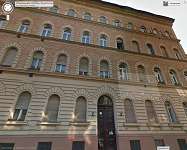
From 1934 to my mother’s death in 2004, our family lived for 70 years at Barcsay Street 11. In 1934, and as a result of the global economic crisis, my great-grandfather Lipót Nemes, a furniture trader, and my grandfather József Fischer, a corn trader, both became poor. My great-grandparents and grandparents decided they couldn’t maintain two apartments any longer, and moved in together.
This is when they rented the third-floor apartment at Barcsay Street 11. My mother was 18 years old at the time, and preparing for her high-school matriculation exams. Her older brother was studying to become an electrical engineer at the German-language university in Prague: because he was of Jewish origin, he could not enroll in a Hungarian university. His sister was nine years old.
After the high school matriculation, my mother studied to become a seamstress, and then worked with her aunt. In the meantime, her brother finished university but there was no chance for him to work as an engineer (because of the anti-Jewish laws). In order not to forgot what he had learned, he went to work for free as an electrician.
In 1939 my mother married a Hungarian Jew who had fled from Poland, they moved to Szövetség Street. In 1941, my great-grandfather died.
Poland had already been occupied by the Germans, and Polish Jews living abroad were caught, put on wagons, made to dig their own graves and then shot. This is what awaited my mother’s husband too.
This is how my mother described what happened:
“One afternoon a woman shouted our names from the street, and told us to flee because my husband’s brother had just been taken away 10 minutes earlier, and now they were coming for us. In meager clothing and slippers, we ran like mad to my mother’s place on Barcsay Street, and learned from the concierge there that they really were looking for us. The concierge said that he hadn’t seen us for a long time, and was sure that we’d been taken away. He was a good man. When the madness died down about a week later, we went back to our apartment. But from that moment on, my life was nothing but fear, and in particular after I learned that my husband’s two sisters and father had already been taken away. My husband was called up again for forced labor service in 1943.”
“On March 19, 1944, the Germans entered the country. This was announced on the radio every 10 minutes. Terrible days followed. Jews had to wear the yellow star. Jewish houses were established, and the Barcsay Street house was one of them. All different kinds of news spread, for example that the cellars of these houses would be filled with gas, and all sorts of things like that. We were advised to go and work in a factory which was part of the war effort, because there you would be protected from the Arrow Cross. My younger sister was already in work using false papers, and it’s through her that I came to the Gyömrői Road brick factory.”
This is where my mother met my father, in the brick factory; he had escaped from forced labor and was working there too. They helped each other hide and both survived the war. My mother’s first husband never returned from forced labor.
My grandparents had to leave the yellow-star house for the ghetto, from where my aunt smuggled them out with false papers and got them into hiding. My great-grandmother was shot in the head by the Arrow Cross when she went out to visit her husband’s grave at the Jewish cemetery.
My grandfather died in 1948 when I was two years old; my grandmother died in 1963. She was the only one of my grandparents I could ever know and love.
I was born in 1947 in Jászberény, where my father had a place. After the war, my parents married and moved to Jászberény. My younger sister was born soon afterward. In 1949 we moved up to Pest, to Barcsay Street 11. I lived here until 1969, when I got married.
2014. May 08., Thursday
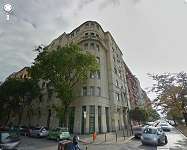
In the ghetto, I learned that my Aunt Etel and her daughter-in-law Manci, together with her ten-year-old grandson Bandi, were staying in a basement at Wesselényi Street 4. Uncle Ignác, Etel’s husband, had been snatched away; we don’t know which death camp he was killed in. Aunt Etel and remaining family were forced to move into the yellow-star house at Sziget Street 40. They were sent to the Óbuda brick factory too, but the old people and parents were allowed to go back home. They could have returned to their apartment, but had moved into the ghetto two months earlier, and their apartment was there on the fourth floor, where the daughter-in-law sometimes went to cook, until she noticed that the roof of the house opposite was higher than usual, and was crumbling to pieces.
A Russian bomb had fallen on it. The Germans had installed automatic guns on countless rooftops at the junction between Wesselényi Street and the ghetto, which they used to try to dispel the Russian military airplanes which appeared regularly every day. They dropped small-sized bombs which regularly caused varying damage not to the air-defense guns, but to the neighboring houses. In fact Jews didn’t have to move out from Sziget Street 4-6, three or four Jewish families stayed behind. One of whom, the wife of a cobbler, seeing my distress, offered me schnitzel made with powdered egg. The house wasn’t designated as a yellow-star house. This was thanks to the vice-concierge’s son, who was an Arrow Cross party activist. They didn’t take over the apartment vacated by my father, we didn’t suffer Arrow Cross raids, and when we had to move, the residents said goodbye. This was exceptional, a unique case in the history of the Arrow Cross rule in Budapest. Our preparations were very chaotic. First we used up Aunt Etel’s limited food reserves. Her last “hobo” apartment before they had to move into the ghetto was in the Palatinus house at the end of Sziget Street. She asked us to bring her the things she’d left behind in a car. I filched a piece of elbow piping so there was no more impediment to laying a fire in the oven in the maid’s room. We dug out the stamp collection which had been hidden underneath a pile of coal in the coal cellar, and one part of my deceased mother’s jewelry. The other half was hidden by a dear friend, Mrs. Pilát, who gave it back in one piece.
From the Centropa archive.
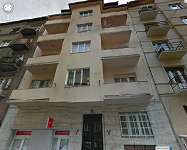
I never experienced any antisemitic incidents before 1944, when someone punched me on the street. We were very afraid in 1944 after the Arrow Cross took over, and took the Jews to the Tattersaal racing track. When the Arrow Cross went from house to house, I remember being very frightened.
And then we escaped this in the house, because my grandfather had a false paper that said he had been condemned to death during Béla Kun’s rule. He showed this to the Arrow Cross and they decided that we could stay at home. The others from the house returned two days later. They didn’t take us away from the house, and again this was due to my grandfather’s genius, because he acquired a fake Swiss protection passport, of course it was perfectly clear that the stamp on the passport was fake. So he made a photocopy of it, and I remember that the whole family’s name was written on it: him, my grandmother, my mother and me, and we went to the corner of Rákóczi Road and the Boulevard where there was a public notary. And he had the photocopy certified, and from that point on we presented our certified copy of a fake document. My grandfather was a very, very refined person. The house on Szövetség Street was declared a Jewish house. I think the majority in the house was Jewish anyway. Although the area around it was not a Jewish area, the house was designated a Jewish house. That’s where we were during the war. And I also remember that on the ground floor there lived someone called Keresényi or something like that, who bought me ice cream from the cake shop opposite, because Jews couldn’t go into cake shops. After the Arrow Cross took over, we had to leave the house: there was some office on Pozsonyi Road and that’s where they designated a protected house for us at Tátra Street 29/b. The apartment wasn’t that crammed full. I don’t remember who we lived with. We’d go down into the basement where there might have been a carpenters’ shop and that’s where we were during the bombings. We cooked there together. I remember eating a bean stew where, instead of using bicarbonate of soda to soften the beans, someone had added anti-moth powder by accident. But we ate it anyway. And that’s where we were liberated, but the Arrow Cross were already going from house to house and taking the Jews to the Danube banks. If the Russians hadn’t arrived two days later, we would have died there too. Countless people died in the Holocaust. Forty from my family. In the family tree I made, there are over 200 hundred names, and I made the tree so my children would know where they come from. I worked on it for years, and when I was in Israel I tried to supplement the information. It’s now finished.
After the war, we went back to Szövetség Street. Some things remained in our apartment, some things had gone. Most of the furniture survived. But my Märklin railway had disappeared. I remember that we didn’t have anything to eat in 1945, and there was a family in the house called Wintermantel, who were jewelers and Christians. They had two children, and I made a deal with them: I’d give them my Märklin railway in exchange for food. But when I went to look for it, I saw it had been taken, it was gone. So the deal was off.
From the Centropa archive.